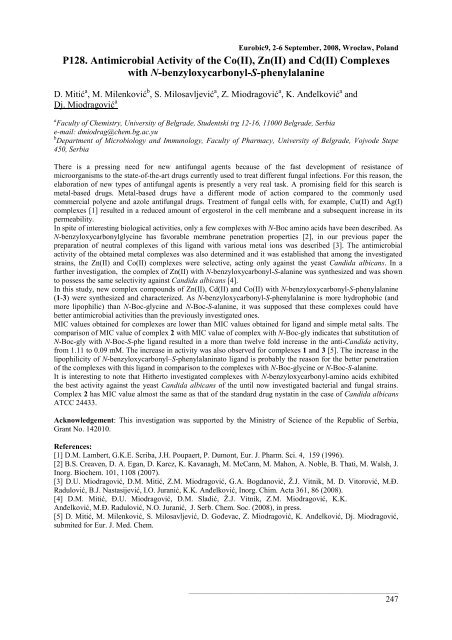ISBN: 978-83-60043-10-3 - eurobic9
ISBN: 978-83-60043-10-3 - eurobic9
ISBN: 978-83-60043-10-3 - eurobic9
You also want an ePaper? Increase the reach of your titles
YUMPU automatically turns print PDFs into web optimized ePapers that Google loves.
Eurobic9, 2-6 September, 2008, Wrocław, Poland<br />
P128. Antimicrobial Activity of the Co(II), Zn(II) and Cd(II) Complexes<br />
with N-benzyloxycarbonyl-S-phenylalanine<br />
D. Mitić a , M. Milenković b , S. Milosavljević a , Z. Miodragović a , K. Anđelković a and<br />
Dj. Miodragović a<br />
a<br />
Faculty of Chemistry, University of Belgrade, Studentski trg 12-16, 1<strong>10</strong>00 Belgrade, Serbia<br />
e-mail: dmiodrag@chem.bg.ac.yu<br />
b<br />
Department of Microbiology and Immunology, Faculty of Pharmacy, University of Belgrade, Vojvode Stepe<br />
450, Serbia<br />
There is a pressing need for new antifungal agents because of the fast development of resistance of<br />
microorganisms to the state-of-the-art drugs currently used to treat different fungal infections. For this reason, the<br />
elaboration of new types of antifungal agents is presently a very real task. A promising field for this search is<br />
metal-based drugs. Metal-based drugs have a different mode of action compared to the commonly used<br />
commercial polyene and azole antifungal drugs. Treatment of fungal cells with, for example, Cu(II) and Ag(I)<br />
complexes [1] resulted in a reduced amount of ergosterol in the cell membrane and a subsequent increase in its<br />
permeability.<br />
In spite of interesting biological activities, only a few complexes with N-Boc amino acids have been described. As<br />
N-benzyloxycarbonylglycine has favorable membrane penetration properties [2], in our previous paper the<br />
preparation of neutral complexes of this ligand with various metal ions was described [3]. The antimicrobial<br />
activity of the obtained metal complexes was also determined and it was established that among the investigated<br />
strains, the Zn(II) and Co(II) complexes were selective, acting only against the yeast Candida albicans. In a<br />
further investigation, the complex of Zn(II) with N-benzyloxycarbonyl-S-alanine was synthesized and was shown<br />
to possess the same selectivity against Candida albicans [4].<br />
In this study, new complex compounds of Zn(II), Cd(II) and Co(II) with N-benzyloxycarbonyl-S-phenylalanine<br />
(1-3) were synthesized and characterized. As N-benzyloxycarbonyl-S-phenylalanine is more hydrophobic (and<br />
more lipophilic) than N-Boc-glycine and N-Boc-S-alanine, it was supposed that these complexes could have<br />
better antimicrobial activities than the previously investigated ones.<br />
MIC values obtained for complexes are lower than MIC values obtained for ligand and simple metal salts. The<br />
comparison of MIC value of complex 2 with MIC value of complex with N-Boc-gly indicates that substitution of<br />
N-Boc-gly with N-Boc-S-phe ligand resulted in a more than twelve fold increase in the anti-Candida activity,<br />
from 1.11 to 0.09 mM. The increase in activity was also observed for complexes 1 and 3 [5]. The increase in the<br />
lipophilicity of N-benzyloxycarbonyl–S-phenylalaninato ligand is probably the reason for the better penetration<br />
of the complexes with this ligand in comparison to the complexes with N-Boc-glycine or N-Boc-S-alanine.<br />
It is interesting to note that Hitherto investigated complexes with N-benzyloxycarbonyl-amino acids exhibited<br />
the best activity against the yeast Candida albicans of the until now investigated bacterial and fungal strains.<br />
Complex 2 has MIC value almost the same as that of the standard drug nystatin in the case of Candida albicans<br />
ATCC 24433.<br />
Acknowledgement: This investigation was supported by the Ministry of Science of the Republic of Serbia,<br />
Grant No. 1420<strong>10</strong>.<br />
References:<br />
[1] D.M. Lambert, G.K.E. Scriba, J.H. Poupaert, P. Dumont, Eur. J. Pharm. Sci. 4, 159 (1996).<br />
[2] B.S. Creaven, D. A. Egan, D. Karcz, K. Kavanagh, M. McCann, M. Mahon, A. Noble, B. Thati, M. Walsh, J.<br />
Inorg. Biochem. <strong>10</strong>1, 1<strong>10</strong>8 (2007).<br />
[3] D.U. Miodragović, D.M. Mitić, Z.M. Miodragović, G.A. Bogdanović, Ž.J. Vitnik, M. D. Vitorović, M.Đ.<br />
Radulović, B.J. Nastasijević, I.O. Juranić, K.K. Anđelković, Inorg. Chim. Acta 361, 86 (2008).<br />
[4] D.M. Mitić, Đ.U. Miodragović, D.M. Sladić, Ž.J. Vitnik, Z.M. Miodragović, K.K.<br />
Anđelković, M.Đ. Radulović, N.O. Juranić, J. Serb. Chem. Soc. (2008), in press.<br />
[5] D. Mitić, M. Milenković, S. Milosavljević, D. Gođevac, Z. Miodragović, K. Anđelković, Dj. Miodragović,<br />
submited for Eur. J. Med. Chem.<br />
_____________________________________________________________________<br />
247


